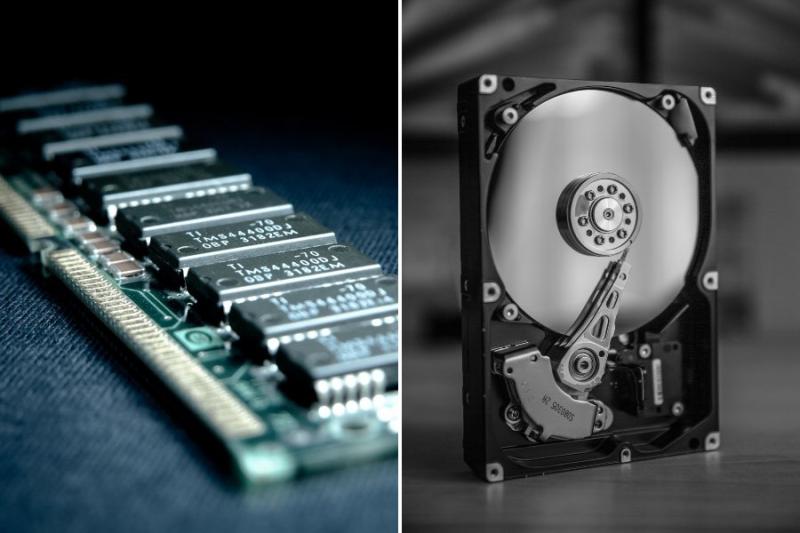RAM (Random Access Memory) and disk (storage) are essential parts of a computer system, but they do different things. RAM is a fast, volatile memory that is used to temporarily store data so that the CPU can get to it quickly while processing. When the power goes out, it loses data. Disks, however, are slower storage devices (like HDDs or SSDs) that keep data even when the computer is turned off. While RAM makes it easy to run multiple programmes simultaneously and keeps them running smoothly, the disk stores files, documents, and software for a long time.
What is RAM?
RAM, or Random Access Memory, is essential to a computer’s performance and operation. It is a volatile memory, which means that when the system is turned off, it loses all of its information. RAM temporarily stores data that the computer’s central processing unit (CPU) needs to get to quickly while it is working. This includes open applications, files, and the operating system.
RAM is made up of memory cells that are arranged in an array. This lets the CPU read or write data at almost the same speed in any part of the memory. This makes it easier to switch between tasks and reduces the time it takes for the CPU to do calculations or carry out instructions. RAM comes in different types, such as DRAM (Dynamic Random Access Memory) and SRAM (Static Random Access Memory). DRAM is more prevalent and must be periodically replenished, whereas SRAM is quicker but costlier and energy-hungry.
RAM size has a direct effect on how well a computer works. More RAM lets the computer handle more data and run more programmes simultaneously. It also makes it less dependent on slower storage devices like hard drives and solid-state drives. But adding more RAM doesn’t help as much after a certain point because the benefits are less noticeable. Overall, RAM is an integral part of any computer system that needs to work well and smoothly.
What is a Disk?
A disk, also called a storage disk, is a device used in computers and other electronic devices to store data that doesn’t lose power. Its main job is to store data forever, even when the system is turned off. There are different kinds of disks, like hard disk drives (HDDs) and solid-state drives (SSDs).
HDDs use magnetic storage made up of spinning disks (called “platters”) covered with magnetic material. A read/write head floats above the moving platters and reads and writes data. HDDs have a lot of storage space for less money per gigabyte, but they are slower to access data and more likely to break. SSDs, on the other hand, store data using NAND-based flash memory. They don’t have any moving parts, so you can get to your data faster, they last longer, and they use less power. SSDs, on the other hand, usually cost more per gigabyte than HDDs.
Disks are needed to store operating systems, software programmes, and user files like documents, pictures, videos, and more and to back up data. The size and speed of a storage disk can significantly affect how well a computer works. Higher capacity lets you store more data, and faster disk speeds make it easier for applications to load and the system to respond. In modern systems, it is common to use both SSDs and HDDs. SSDs are used for faster access to frequently used data, while HDDs store larger amounts of data used less often.
Difference Between RAM and Disk
RAM (Random Access Memory) and disk (storage) are essential but functionally distinct parts of every computer system. RAM and disk differ significantly in how they store data, how quickly they can access it, and how much money they cost.
Data Storage Nature
A computer’s central processing unit (CPU) temporarily stores data that it frequently accesses during processing in RAM, also known as volatile memory. If the power goes out, the data stored in memory will be erased. On the other hand, disks are hard disk drives or solid-state drives (HDDs or SSDs) that store data indefinitely and reliably, even when the power is turned off.
Speed
Hard drives (HDDs) and solid-state drives (SSDs) are both slower than random access memory (RAM). The Processor can access data in RAM far faster than it could via a disk. The ability to multitask with ease and run applications quickly is made possible by this speed.
Capacity
Disk storage has a far bigger capacity than random access memory (RAM), making it ideal for the archival storage of huge files, documents, and programmes. RAM has limited storage because it only keeps information that is currently being used.
Cost
Due to RAM’s faster speed and more sophisticated architecture, it is typically more expensive per gigabyte than Disk storage. SSDs cost more than HDDs, but they’re quicker and last longer.
In conclusion, RAM and Disk both play unique responsibilities in a computer. RAM is a faster, temporary storage option that helps with multitasking and processing, whereas disk is a more permanent option for storing big amounts of data and applications. To get the most out of your computer, you need to have a firm grasp on the distinctions between these two parts in terms of both speed and storage space.






